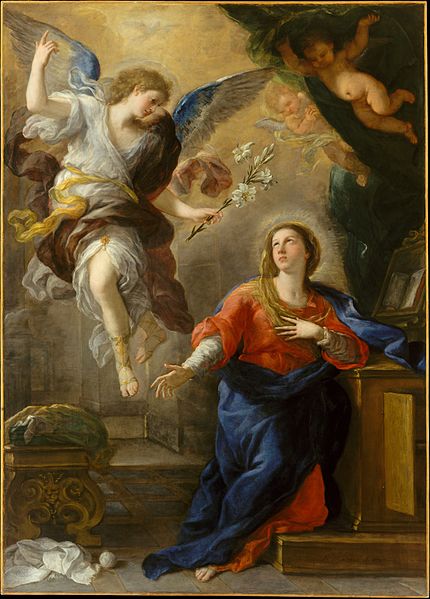 by Theresa Cavicchio
by Theresa CavicchioTo honor Our Lady on this Feast of the Visitation, we focus our reflection on her inspirational hymn of praise, the Magnificat (Lk 1:46 – 55).
Commenting on the Magnificat in his encyclical Redemptoris Mater (Mother of the Redeemer), Pope Saint John Paul II teaches: “In these sublime words, which are simultaneously very simple and wholly inspired by the sacred texts of the people of Israel, Mary's personal experience, the ecstasy of her heart, shines forth. In them shines a ray of the mystery of God, the glory of his ineffable holiness, the eternal love which, as an irrevocable gift, enters into human history” (36).
In light of this edifying introduction, we visit the scene of the Visitation. In the aftermath of the Annunciation by the Angel Gabriel (Lk 1:26 – 38), Mary sets out “in haste” from Nazareth to the home of her cousin Elizabeth in the hill country of Judah (39 – 56). For besides imparting the stunning news of Mary’s selection by God as the Mother of His Son, the angel has shared another startling revelation. Although past childbearing age, Elizabeth and her husband Zechariah also are awaiting the birth of a son, now in his sixth month of gestation.
Elizabeth, “filled with the Holy Spirit” at the unexpected arrival of her young kinswoman, and prompted by her unborn baby leaping in her womb, acknowledges Mary as “blessed among women” and “the mother of my Lord.”
Springing forth from her deep faith and humility comes Mary’s response – the glorious hymn of praise whose title derives from its beginning words in Latin: Magnificat anima mea Dominum.
“My soul proclaims the greatness of the Lord, my spirit rejoices in God, my Savior . for He has looked with favor on His lowly servant.
From this day all generations will call me blessed: the Almighty has done great things for me, and holy is His name.
He has mercy on those who fear Him in every generation.”
Pope Benedict XVI, in a 2006 address, speaks beautifully to this initial section: “… the soul of the prayer is the celebration of the divine grace which has burst into the heart and life of Mary, making her Mother of the Lord. We hear the Virgin’s own voice speaking of her Savior who has done great things in her soul and body. The intimate structure of her prayerful canticle, therefore, is praise, thanksgiving, and joy.”
“He has shown the strength of His arm. He has scattered the proud in their conceit.
He has cast down the mighty from their thrones, and has lifted up the lowly.
He has filled the hungry with good things, and the rich He has sent away empty.
He has come to the help of His servant Israel, for He has remembered His promise of mercy, the promise He made to our fathers, to Abraham and his children forever.”
Pope Benedict portrays these seemingly paradoxical actions of God, repeated throughout history, in this light: “[God’s] plan is one that is often hidden beneath the opaque context of human events that see ‘the proud, the mighty, and the rich’ triumph. Yet His secret strength is destined in the end to be revealed, to show who God’s true favorites are … the People of God who, like Mary, consist of people who are ‘poor,’ pure, and simple of heart … And this Canticle invites us to join … the true members of the People of God in purity and simplicity of heart, in God’s love.”
Throughout the Gospels, we see that these themes woven through the Magnificat also characterize Jesus’ preaching and teaching ministry: God’s bountiful, endless love and mercy; the fulfillment of His promises to the ancient fathers; the proud and the rich laid low and left hungry, the lowly elevated and well fed.
Returning to Pope Saint John Paul II, we find further encouragement: “The Virgin Mother is constantly present on this journey of faith of the People of God towards the light. This is shown in a special way by the canticle of the ‘Magnificat,’ which, having welled up from the depths of Mary's faith at the Visitation, ceaselessly re-echoes in the heart of the Church down the centuries” (35).
The Holy Father’s words are borne out as members of the faithful – worldwide, every single day – recite the Magnificat during Vespers (Evening Prayer of the Liturgy of the Hours). Through her canticle of praise, Mary will go on reaching across the generations universally – back to the Old Testament fathers of antiquity, and far into the future, to our own day and beyond.
As Mary foretold, she truly has been called blessed through all generations, and will continue to be, every time a Hail Mary is prayed – lisped by wee ones kneeling at their bedsides, whispered by elders fingering beads worn with the work of years – at home, in church, in the silence of loving hearts everywhere.
Mary’s Magnificat reminds us that its message rings true for us in our own day just as it did for her and for her people two thousand years ago. Her canticle of “praise, thanksgiving, and joy” stands firm, a beacon of hope much needed in a world often shrouded in darkness.
Our Lady of the Magnificat, pray for us!
© All Rights Reserved, Living His Life Abundantly®/Women of Grace® http://www.womenofgrace.com
